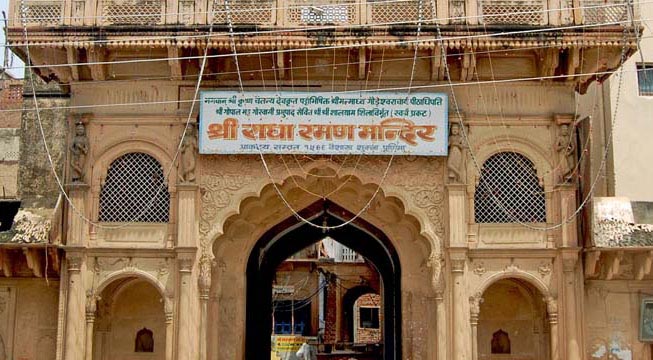Radha Raman Temple

Information of Radha Raman Temple, Vrindavan, Mathura, Uttar Pradesh
Radha Raman Temple is an ancient Hindu temple situated in Vrindavan. It is dedicated to god Krishna as the form of Radha Ramana. Radha Raman Temple was created in accordance with the appeal of Gopala Bhatta Gosvami in the year 1542 AD. He was one of the foremost followers of Vaishnava saint. The temple is beautifully created and it is regarded as one of the most admired temples in Vrindavan. Radha Raman Temple houses the real idol of lord Krishna alongside goddess Radha.
Radha Raman Temple Religious Significance
Radha Raman Temple organises various religious festivals for example, Jhulan Yatra. This festival occur at the beginning of rainy season, i.e. during the month of July or August. On this occasion, the small idols are brought out in the courtyard and organised in a beautiful gold plate. The other popular event in Radha Raman Temple is Janmashtami which is celebrated during the month of August or September. On this festival, thousands of devotees worship lord Krishna. This festival is characterised by Bhog offerings and religious activity named Arati on midnight. After 15 days of Janmashtami festival, Radhashtami festival is also celebrated in Radha Raman Temple.
Kartika which is also termed as Damodara is another religious festival which occur in Radha Raman Temple. On this occasion, devotees offers lamps to the idols and chant the splendours of lord Krishna as well as his childhood activities. Vasant Panchami is another festival of Radha Raman Temple which occur during the month of January or February. In this occasion, devotees outfit in yellow clothes which is admired by lovely flower beautifications. Apart from that, other popular festivals which occur in Radha Raman Temple are Gaura Purnima, Ram Navami, Chandan Yatra and Balaram Purnima. Almost all the festival that are organised here are celebrated with great pomp and show, adding more beauty and importance to the temple among the devotees.
Radha Raman Temple Mythology & History
In Hindu mythology, Radha Raman signify the lover of goddess Radha, i.e. lord Krishna. According to legend, Gopala Bhatta Gosvami, the creator of radha Raman Temple arrived in Vrindavan when he was 30 years old. He was regarded as one of the six Gosvamis of Vrindavan. These Gosvamis were the followers of Chaitanya who had encouraged the worship of lord Kirshna. Legend states that after the disappearance of the Chaitanya, Gopala Bhatta Gosvami felt strong sense of departure from god. In order to release his devotees from the spasms of departure, lord Krishna guided Gopala Bhatta in a dream to visit Nepal. In Nepal, Gopala Bhatta bathed in Kali Gandaki River and dipped his waterpot. While dipping the waterpot, he observed several Shaligrama rocks had entered into his pot and upon dropping those stones, they again returned into the pot. There was about 12 Shaligrama rocks which was believed to be given to Gopala Bhatta by a rich person for idol decorations, but he never used them. Afterwards he bring the sacred rocks with him in Vrindavan.
In a full moon day, after offering worship to Shaligrama rocks Gopala Bhatta put them in a bamboo basket. In morning when he left to take a bath in river Yamuna, one of the Shaligrama rocks become an idol of lord Krishna, playing a flute. The rock had revealed into a threefold bending form of lord Krishna. As a result, Radha Raman appeared in a perfectly designed divinity from sacred Shaligrma rock. This idol created the basis for establishment of Radha Raman Temple.
Radha Raman Temple Architectural Significance
Radha Raman Temple is based on Hindu architectural style. A self-manifested idol of Saligram stone is existed inside Radha Raman Temple. The idol has a spiritual smile on its face. The temple is quite large and have a scenic beauty of riverside areas. Inside the temple compound, there is also a tomb of the creator, i.e. Gopala Bhatta Goswami. Furthermore, Radha Raman Temple also houses the seldom available clothes used by guru Chaitanya. Owing to its location and the splendid work, the splendid architectural phenomenon marks Radha Raman Temple as a revered temple in Vrindavan.
- Andhra Pradesh Temples
- Assam Temples
- Bihar Temples
- New Delhi Temples
- Goa Temples
- Gujarat Temples
- Jammu and Kashmir Temples
- Karnataka Temples
- Kerala Temples
- Madhya Pradesh Temples
- Maharashtra Temples
- Odisha Temples
- Punjab Temples
- Rajasthan Temples
- Sikkim Temples
- Tamil Nadu Temples
- Telangana Temples
- Uttar Pradesh Temples
- Uttarakhand Temples
- West Bengal Temples